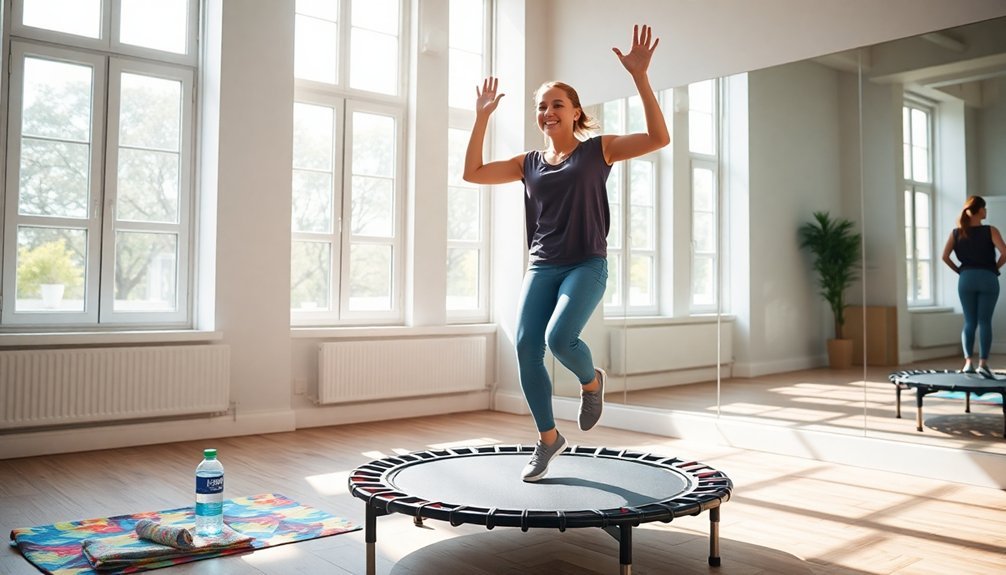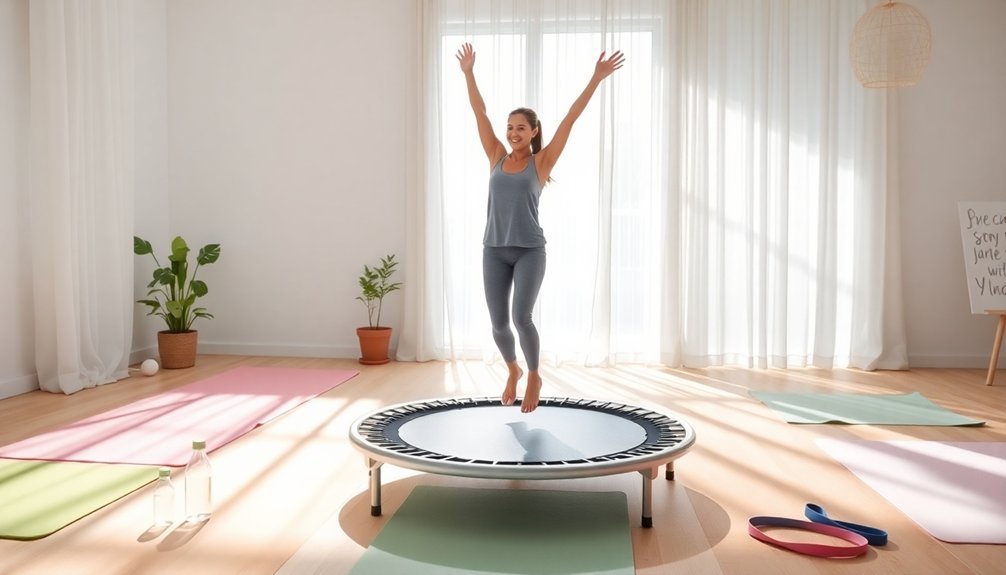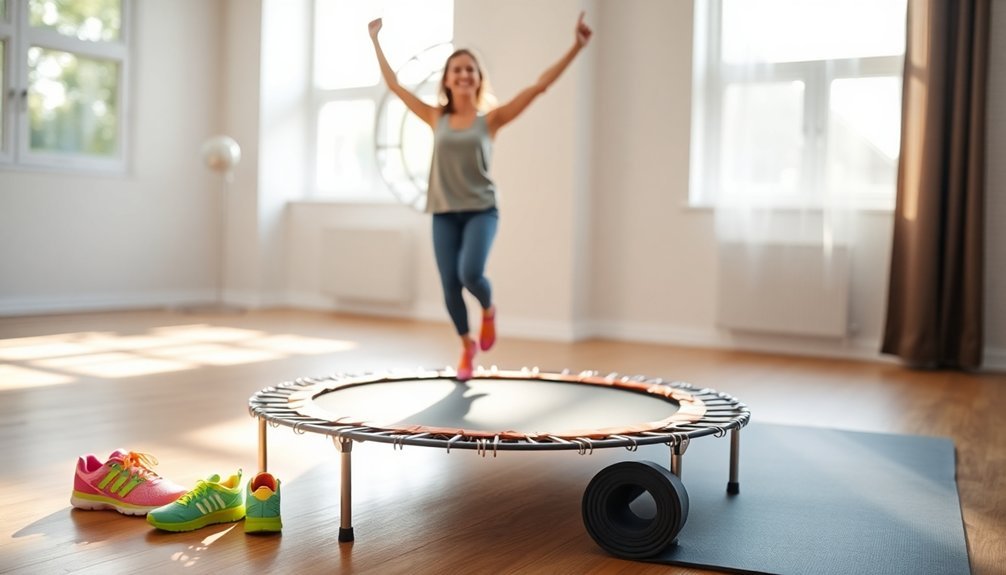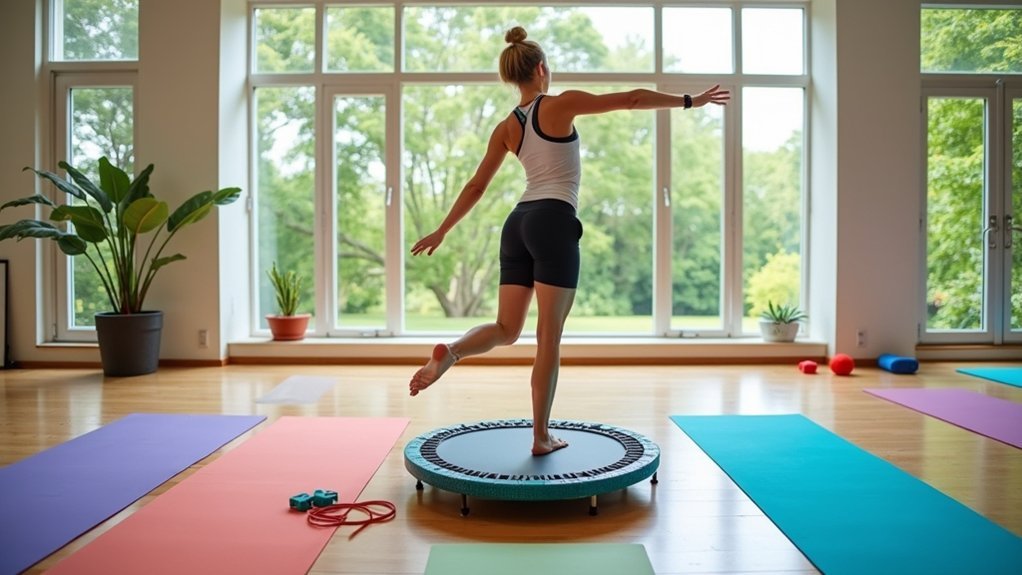Start with the health bounce by gently bouncing while keeping your feet on the trampoline. Progress to marching in place, toe taps, and side steps for 5-10 minutes per session. Wear nonslip shoes, position your feet slightly wider than hip-width, and engage your core throughout. Begin with 2-minute daily sessions, gradually increasing as you gain confidence. The following techniques will transform your rebounding journey from beginner to confident bouncer.
Getting Started With Basic Bounce Techniques

While rebounding might seem as simple as jumping on a mini-trampoline, mastering the proper techniques will maximize your workout benefits while protecting your joints.
Begin with the health bounce—a gentle movement where you're barely leaving the mat, simply pressing your feet downward to create subtle elevation.
Maintain a straight back and engage your core throughout each movement. As you gain confidence, incorporate arm movements to enhance the workout intensity.
Try progressing to marching in place, toe taps, and side steps before attempting jogging. Like jump rope, these exercises require practice and patience to build your coordination and endurance over time.
Start with just 15 minutes per session, focusing on proper form rather than duration. Keep movements light and controlled, allowing the trampoline to absorb impact.
Remember to warm up with gentle bouncing before increasing your intensity or trying more complex movements.
Essential Safety Tips for First-Time Rebounders
Wearing proper nonslip footwear on your rebounder prevents dangerous slips and provides essential traction during your workout.
Begin with simple, low bounces for just 5-10 minutes to allow your body to adjust to this unique form of exercise. As your confidence and balance improve, you can gradually increase both the duration and complexity of your rebounding routines. Always maintain an athletic stance with your hips back and knees slightly bent to ensure proper form and prevent potential injuries.
Proper Footwear Matters
The right footwear can make or break your rebounding experience. Cotton socks are generally your safest bet as they don't slide around much on the rebounder surface. Avoid slippery materials that could lead to accidents during your workout. Always ensure your trampoline is positioned away from walls and other furniture to prevent injuries if you lose balance while jumping.
| Footwear Type | Recommendation | Safety Level |
|---|---|---|
| Cotton Socks | Excellent choice | High |
| Grip Socks | Best for stability | Very High |
| Regular Shoes | Use only if non-slip | Moderate |
For maximum safety, consider socks with textured soles or grip patterns. If you're rebounding outdoors, verify the surface is completely dry before beginning your routine. While specialized rebounding shoes exist, they're not necessary—most users find that good quality non-slip socks provide sufficient traction and comfort while allowing you to feel the trampoline's surface properly.
Start Slow, Progress Gradually
Beginning a rebounding practice requires patience and attention to form, especially for first-time users who might feel enthusiastic to jump right in.
Start with just 5-10 minute sessions, focusing on the foundational Health Bounce with slight waist hinges and gentle heel lifts to activate your lymphatic system.
Maintain micro bends in your knees to protect your joints, and keep your core engaged throughout each movement.
Position your feet wider than hip-width apart while maintaining a mini squat position to ensure proper alignment during your bouncing exercises.
As you build confidence, gradually introduce In and Out movements and Front to Back Hops to improve your balance and coordination.
Always position your trampoline near a wall or sturdy furniture for support if needed.
Listen to your body and progress at your own pace—widening movements or adding small jumps only when you're comfortable with the basics.
5-Minute Gentle Rebounding Routines for Beginners

Five-minute gentle rebounding routines offer an ideal starting point for newcomers to trampoline exercise.
You'll find these short sessions manageable yet effective for building confidence and fitness foundations.
Start with simple bouncing, which requires no choreography—just gentle movement to get comfortable on the rebounder.
Then progress to basic low-impact moves like toe taps, heel lifts, and side steps that minimize joint stress while enhancing balance and core strength.
For variety, try marching in place to warm up your legs or incorporate wide bounces to improve stability.
Remember to slightly bend your knees during the basic bounce to improve circulation and posture.
Most routines repeat exercises to build familiarity, and you can always modify movements by reducing range or pace if needed.
An effective rebounding workout can include an active twist exercise that engages your core by interlacing fingers and twisting side to side.
Proper Form and Posture for Effective Low-Impact Bouncing
Proper posture while rebounding creates the foundation for an effective and injury-free workout experience.
Stand with feet slightly wider than hip-width for stability, and engage your core to support your lower back. Keep your shoulders relaxed away from your ears while maintaining a straight spine from tailbone to head.
Proper foot placement and core engagement create the foundation for safe rebounding, with relaxed shoulders and a tall, aligned spine.
Focus your gaze straight ahead to maintain balance, and remember to press down into the trampoline rather than jumping high to minimize joint impact. Emphasize flat foot strikes to properly engage your glutes and hamstrings throughout each bounce.
Begin with a wider stance for stability, then narrow it as your confidence grows. Keep your arms loose at your sides or incorporate gentle swings similar to running.
Don't forget to breathe naturally throughout your bouncing session. If needed, use a handlebar for additional support until you develop better balance.
Building Core Strength With Simple Rebounding Movements

Targeting your core muscles while rebounding multiplies the benefits of this already effective exercise. Your trampoline provides an unstable surface that naturally engages your abdominal muscles during even the simplest movements.
| Exercise | Core Benefit |
|---|---|
| Basic Bounce | Engages stabilizing muscles |
| V-Ups | Targets entire abdominal wall |
| Plank Variations | Builds core endurance |
| Knee Drive | Strengthens lower abs |
Start with air bike crunches by lying on the trampoline, hands behind your head, alternating knees to elbows. For a standing option, try the jump and tuck, where you squat then jump while pulling your knees toward your chest. Single leg balances are perfect for beginners—simply lift one foot while lightly bouncing on the other, keeping your core tight throughout the movement. Using a handlebar for support can make exercises like jump and tuck more manageable when starting out with trampoline workouts.
Gradually Progressing Your Rebounding Practice
As you progress in your rebounding journey, set small, achievable goals that motivate rather than overwhelm you.
Start by adding just 30 seconds to your routine each week, which builds endurance without risking burnout or injury.
Mix different exercise types from basic bounces to side-to-side movements to keep your practice fresh and challenge different muscle groups. Consider incorporating targeted exercises like rebounder prancing, alternating lunges, and core twists to enhance overall fitness and develop multiple muscle groups simultaneously.
Set Achievable Goals
Setting realistic goals forms the foundation of any successful rebounding practice. When you're new to rebounding, start small and gradually build your capacity over time. This approach prevents discouragement and reduces injury risk while keeping you motivated.
Consider these goal-setting strategies for your rebounding journey:
- Begin with 5-10 minute sessions 2-3 times weekly, then gradually increase to 20-30 minutes as your endurance improves.
- Master basic bounces before attempting more complex movements like jogging or jumping jacks.
- Track your progress by noting improvements in balance, endurance, or decreased recovery time.
- Create a 4-week plan with specific weekly milestones (e.g., "Add arm movements to basic bounce by week 2").
Remember that consistency trumps intensity when you're starting out. Maintain proper form with feet wider than hips and a micro bend in knees to ensure safe and effective rebounding sessions.
Add Time Gradually
Gradually building your rebounding time guarantees your body can adapt safely while maximizing fitness benefits. Start with just 2-10 minutes daily, then increase your sessions as your confidence grows. For absolute beginners, the Foundation Programme offers a structured approach starting with 2-minute sessions and progressively building up to 20-minute workouts over four weeks.
| Week | Duration | Frequency | Intensity |
|---|---|---|---|
| 1-2 | 5 min | Daily | Gentle bouncing |
| 3-4 | 10 min | Daily | Add knee lifts |
| 5-6 | 15 min | 5x weekly | Incorporate arm movements |
| 7+ | 20+ min | 4-5x weekly | Mix in jumping variations |
Listen to your body's signals—if you feel pain or excessive fatigue, reduce your time or intensity. Consistency trumps duration, so it's better to maintain shorter, regular sessions than push yourself too hard and abandon your practice. Your rebounding endurance will naturally develop when you respect your body's adaptation timeline.
Mix Exercise Types
Once you've established a consistent rebounding routine, diversifying your exercise types becomes crucial for ongoing progress. Your body adapts quickly to repetitive movements, so incorporating variety helps maximize benefits while keeping workouts engaging.
Mix these exercise types into your rebounding practice:
- Low-impact to high-intensity progression: Start with basic bouncing and marching, then gradually add jogging and more dynamic movements.
- Directional variations: Incorporate side-to-side jumps, front-to-back bounces, and diagonal movements to challenge different muscle groups.
- Upper body integration: Add arm movements like punches or reaches while bouncing to create full-body workouts. Consider including movements such as the Side Tap with Jack Arms which mimics jumping jacks while providing stability.
- Strength and cardio combinations: Alternate between strength exercises like jump squats and cardio intervals for thorough fitness.
This varied approach guarantees continued improvement while preventing workout boredom.
Incorporating Balance Exercises for Stability Improvement
Balance exercises, when combined with rebounding, create a powerful duo for enhancing stability and reducing fall risks.
Try incorporating single-leg stances while on your mini-trampoline to improve proprioception and body awareness. As you gain confidence, add weight shifts with small hand weights to challenge your core strength.
The heel-to-toe walk can also be integrated between bouncing sessions to enhance footwork coordination.
Don't forget sideways movements during your routine—these lateral steps greatly improve your side-to-side stability. Throughout all exercises, maintain core engagement by drawing your navel toward your spine. This maximizes balance benefits while protecting your lower back.
Remember to start with modified versions if needed, and always verify your equipment can safely support your weight and activity level. Studies show that consistent balance training is particularly important for older adults as it significantly reduces the risk of falls and helps maintain independence.
Frequently Asked Questions
Can Rebounding Help With Specific Health Conditions Like Arthritis?
Yes, rebounding can help with arthritis due to its low-impact nature. You'll experience less joint stress while improving mobility as it enhances synovial fluid circulation. Always consult your doctor before starting this exercise.
How Do Rebounding Benefits Compare to Traditional Cardio Exercises?
Rebounding gives you similar cardiovascular benefits to traditional cardio but with less impact on your joints. You'll enjoy more efficient lymphatic stimulation, full-body muscle engagement, and often need less time for equivalent results.
Will Rebounding Affect My Downstairs Neighbors in an Apartment?
Rebounding can disturb downstairs neighbors. You'll create noise and vibrations that travel through floors. Place a thick mat under your trampoline, choose quieter hours, and consider using carpeted areas to minimize impact.
How Much Weight Can a Typical Rebounder Safely Support?
Most rebounders support 230-300 pounds, with premium models handling up to 440 pounds. You'll find 40-inch models typically support 230 pounds, while larger 48-inch models can handle up to 250 pounds.
Can Children Safely Use the Same Rebounder as Adults?
Yes, children can safely use the same rebounder as adults if it has adequate weight capacity, is stable, and you provide proper supervision. Always check manufacturer guidelines and supervise kids during their rebounding sessions.
In Summary
You've now discovered several beginner-friendly rebounding exercises that'll strengthen your body while minimizing joint stress. Start with basic bounces, maintain proper posture, and gradually increase your workout duration. Remember to prioritize safety by checking your equipment and wearing supportive shoes. As you become more comfortable, you'll notice improvements in your balance, core strength, and overall fitness. Keep bouncing—your body will thank you!





Leave a Reply